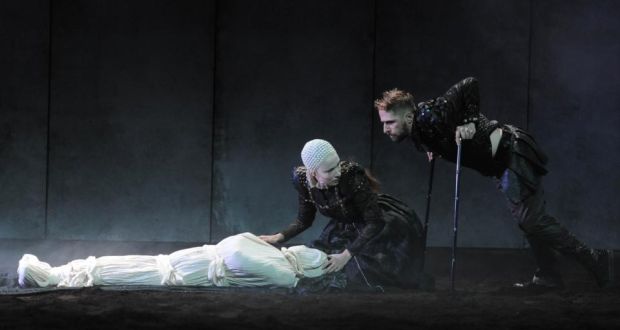
Shakespeare, once the object of every sensible pupil’s hatred, is cool again, and the same kids who mocked his works in school are now the adults lining down the block to see them staged. Four centuries after his death, the Bard of Avon is drawing incredible crowds to Richard III at The Abbey, aided no doubt by the excellent reputation garnered by theatre company DruidShakespeare.
The play begins with a loud bang, as the Duke of Gloucester kicks open one of the grey metal panels lining the stage and launches into the familiar opening soliloquy. Dressed in a dark leather ensemble, one sleeve adorned with shimmering sequins, Aaron Monaghan sets out the hallmarks of his Richard: Machiavellian scheming, impeccable comic timing and exaggerated dramatic irony. The essence of this Richard, the audience quickly understands, is humour and charm, and somehow, as he expounds his deadly plans, we are surprised to find ourselves suddenly – but resolutely – on his side.
Richard III depends for its effect on the equal monstrosity and charisma of the titular royal. But in this production, despite Monaghan’s violent, jerky swaggering around the stage, there’s nothing very monstrous about Richard at all. One result of this “likeable” anti-hero is that the play struggles to build up any real sense of horror, even as the action descends into chaos. When Richard throws an enemy’s severed head into the same barrel his brother was drowned in, for example, the audience bursts into hysterics rather than screams – and with that, the fine, compelling balance between hero and villain seems lost.
But in a way, funny Richard works – probably due to the brilliance of the rest of the production. Francis O’Connor’s excellent set design is deceptively bare. A skull hangs from above. Soil covers the floor, roughened and muddied by the actors’ nervous trampling as the play takes its course. The towering grey panels that fence the stage, swivelling to facilitate entrances and exits, increase the impression of a whirlwind unleashing itself before us. At times the ingenious lighting by James F Ingalls transforms the stage into an abattoir, and an open grave gapes in the earthen floor.
This clever, economical set design represents the ethos of DruidShakespeare’s production, which somehow manages to create a dream of royal excess (as in Queen Elizabeth’s dazzling all-gold attire) in tandem with a minimalist approach that strips away the play’s natural clutter. Richard III is notorious for its myriad of characters and their often long-winded dialogue but this version, directed by Garry Hynes, retains only the essential. Two monks are even replaced by cassocked scarecrows.
The acting, on the whole, is superb and – in what’s a real feat for a modern Shakespearean production – nobody ever sounds like they’re just reciting lines in a language they don’t really understand. The female characters in the play (Queen Elizabeth, Queen Margaret, Duchess of York and Lady Anne) see a significant proportion of their lines omitted in this sleek cut, but they nevertheless play the greatest role in resisting Richard’s murderous ascent.
After the honourable Richmond triumphantly slays Richard, he proclaims that “the bloody dog is dead”. DruidShakespeare, however, refuses the audience a staid happy ending, and a final arresting image suggests that the corruptive effects of power have not been overcome.
As part of the Dublin Theatre Festival, Richard III is running at The Abbey until October 27th.






